-

人教版新目标初中英语九年级下册Could you please tell me where the restrooms are教案
Step Ⅰ RevisionCheck homework. Ask a few students to read the article in 3a.Then ask a few students to read their guides.Step Ⅱ Part 1Look at the words in the box. Ask a student to read them. Make sure the students understand the meaning of the words. You are to fill in the blanks with the words. In some cases, students may need to use another form of the word, for example adjusting for tense or subject/ verb agreement.Ask students to fill in the blanks on their own.Check the answers. Step ⅢPart 2Go through the instructions with the class.Look at the example with the students.Ask students what the answer would be.Ask a student to read the question and answer it.Excuse me, could you tell me where the bank is, please?The bank is across the street from the shopping malt.Get students to complete the work in pairs.Check the answers. Ask a few students to read their questions.Step Ⅳ Just for Fun!Ask all the students to read the conversation. Ask: What is funny about this cartoon? Help students to explain. A Martian is a person from the planet Mars.There is no such thing as Martian food on Earth, and the clerk looks silly because he is trying to think of where there is a Martian restaurant.Invite some pairs of students to present this conversation to the rest of the class.Step Ⅴ Summary and HomeworkIn this class, we’ve done much writing practice using the key vocabulary words and the target language presented in this unit. After class, please finish the questions in 2 in your exercise books. Then finish the exercises on pages 47~48 of the workbook as well.The Seventh Period Ⅰ Teaching Aims and Demands1. Knowledge Objects(1) Key Vocabularyimage, adventure, jealousy, hero, crime, journey, brave, no longer, show interest in, take it easy, become interested in, plain looks(2)Text:Grown-ups like cartoons, too.2. Ability Objects(1) Fast-reading to get a general idea of the text.(2) Careful-reading to get the detailed information in the text.

人教版新目标初中英语九年级下册I’ll help clean up the city parks教案
Talk about offering help (P60)I’ll help clean up the city parks.A: I’d like to work ...B: You could help ...Talk about ways to tell people about the Clean-Up Day (P61)We need to ...We can’t ...I’ll ...Talk about the work the volunteers do (P62)These three students all volunteer their time to help other people.Somebody loves to ... / helps ... / plans to ... / wants to ...A: What do you like doing?B: I like ... A: What kind of volunteer work do you think I could do?B: You could ...1. 重点词汇advertisement, fix, repair, pleasure, blind, deaf, shut, carry, specially, fetch2. 认读词汇hunger, homeless, cheer, clean-up, sign, establish, major, commitment, elementary, veterinarian, coach, similar, call-in, strategy, disabled, organization, unable, support, appreciate, donation, part of speech, pronoun, adverb, preposition, conjunction, donate, Jimmy, Sally3. 词组clean up, cheer up, give out, put off, set up, think up, take after, fix up, give away, put up, hand out, work out, at once

人教版新目标初中英语九年级下册We’re trying to save the manatees教案2篇
本单元主要围绕着有关濒临灭绝的动物这一话题,学习了应该怎样保护我们的环境,以及就某一问题展开辩论。目标提示语言目标能够运用所学知识,就某一问题展开辩论。认知目标1、复习一些语法:现在进行时、一般现在时、用used to 表示一般过去时、现在完成时、一般过去时的被动语态。2、学会表达同意和不同意。3、学会以下基本句型:We’re trying to save the manatees.Manatees eat about 100 pounds of food a day.There used to be a lot of manatees.In 1972,it was discovered that they were endangered.Some of the swamps have become polluted.情感目标了解一些濒临灭绝的动物的生活习性和濒临灭绝的原因,教育学生应该如何保护环境。教学提示充分利用多媒体等教学设备,创设与本课话题相关的情境,如各种不同种类的动物、动物园以及有关环境的画画等等。围绕着本单元的教学目标,设计一些贴近学生实际的教学任务,如让学生谈论自己最喜欢的动物,如何拯救濒危动物,如何保护环境等等。让学生根据所学知识,就动物园是否对动物有利以及其他的话题进行辩论。

人教版新目标初中英语九年级下册You’re supposed to shake hands教案
教学目标:1. 掌握本单元一些重点词汇的写法和用法。2. 学会自如谈论餐桌礼仪。Step 1 RevisionAsk some students to retell the customs at the table in France in the passage in 3a.Step 2 Self checkPart 1. Fill in each bland with the correct word given. Students do the exercises by themselves at first. Then check the answers. Ask the students to comprehend the sentences and help them point out uses of some words, like “arrive (at / in) sw., spend time / money on sth , spend time / money (in) doing sth.”Part 2. Read about Fan Ling’s experience in a western restaurant. Understand the passage. Point out some key points in the passage.1. be / get used to doing sth. 习惯做某事2. begin with = start with 以….开头3. crowd v. 挤满,塞满 the crowd 人群 crowded adj. 拥挤的Then students discuss about how she would solve her problem. Ask some to share their stories with others.Part 3. Complete the crossword by looking at the sentences on the left. Then check the answers.
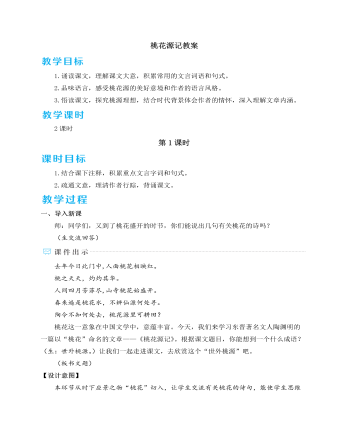
人教部编版语文八年级下册我一生中的重要抉择教案
五、总结存储1.教师总结这篇演讲词,作者用幽默诙谐的语言阐述了自己人生中的一个重要抉择——大力扶植年轻人。作者善于自我调侃,在自我解剖中进行了深入的分析,强调了扶植年轻人的重要性和必要性。演讲中列举了大量名人事例进行论证,使演讲具有很强的说服力。这篇演讲词展示了一位科学家精彩绝伦的语言魅力:不但有科学原理,而且有人生哲理;不但有学术的穿透力,而且有情感的震撼力;不但有理论的清晰度,而且有语言的幽默感——这一切构成了王选演讲的独特风采。我们在体会王选演讲魅力的同时,也领略到了他的人格魅力。2.布置作业(1)人的一生所做的重要抉择,如果与时代和国家紧密相连,意义会更加重大。我们在人生的关键阶段,如选择未来事业时,会做出怎样的抉择?请你写一段200字左右的演讲词,并在小组内演讲交流。(2)课外阅读王选的《我一生中的八个重要抉择》。
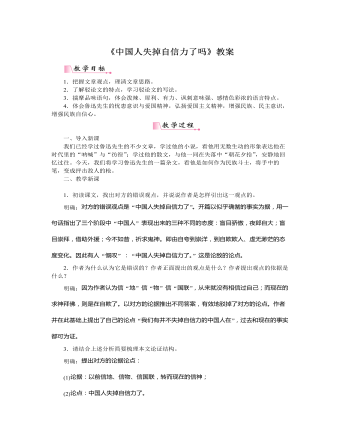
部编版语文九年级上册《中国人失掉自信力了吗》教案
一、导入新课我们已经学过鲁迅先生的不少文章,学过他的小说,看他用无数生动的形象表达他在时代里的“呐喊”与“彷徨”;学过他的散文,与他一同在失落中“朝花夕拾”,安静地回忆过往。今天,我们将学习鲁迅先生的一篇杂文,看他是如何作为民族斗士,将手中的笔,变成抨击敌人的枪。二、教学新课目标导学一:学习驳论,理清思路1.初读课文,找出对方的错误观点,并说说作者是怎样引出这一观点的。明确:对方的错误观点是“中国人失掉自信力了”。开篇以似乎确凿的事实为据,用一句话指出了三个阶段中“中国人”表现出来的三种不同的态度:盲目骄傲,夜郎自大;盲目崇拜,借助外援;今不如昔,祈求鬼神。即由自夸到崇洋,到自欺欺人、虚无渺茫的态度变化。因此有人“慨叹”:“中国人失掉自信力了。”这是论敌的论点。
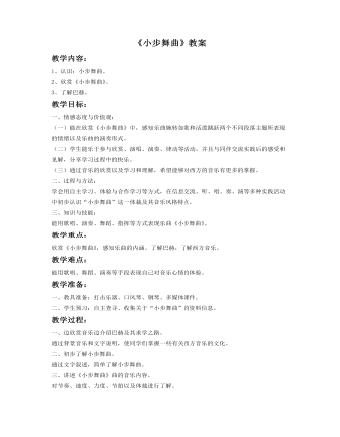
《小步舞曲教案》教案
教学过程:一、边欣赏音乐边介绍巴赫及其求学之路。通过背景音乐和文字说明,使同学们掌握一些有关西方音乐的文化。二、初步了解小步舞曲。通过文字叙述,简单了解小步舞曲。三、讲述《小步舞曲》曲的音乐内容。对节奏、速度、力度、节拍以及体裁进行了解。四、结合谱例分段学习《小步舞曲》。1、学习乐曲A’段。说明:依据乐曲创作背景,合理创设“舞会”情景,从而有效激发学生学习兴趣,用舞蹈表现手段演绎此乐段,发展了学生的舞蹈表演能力,享受到美的愉悦。2、学习乐曲B段。说明:利用形象、直观的图式辅助以及一系列贴近学生思维逻辑的问答讨论,激发学生的思考,帮助学生准确把握乐段情绪,并能用指挥、伴奏等方式表现该乐段。3、完整欣赏《小步舞曲》。说明:学生在完整欣赏乐曲时能够巩固乐曲主题的记忆,并且听辨、感受乐曲两个不同主题情绪,培养学生独立的音乐感受和见解。五、视频欣赏。说明:通过视屏欣赏,使同学们以一个更直观的郊区去理解和学习作品,并使同学对作品有更深刻的记忆。引起学生共鸣,领悟音乐的美感,愉悦身心,获取乐趣,从而激起学习的情趣。
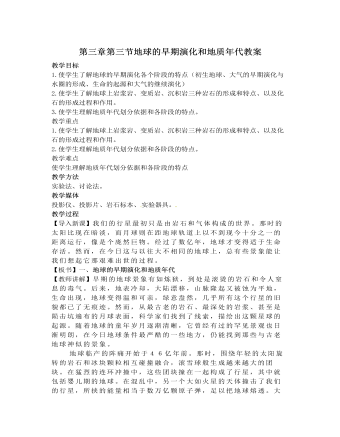
人教版高中地理选修1第三章第一节地球的早期演化和地质年代教案
地质年代可分为相对年代和绝 对年龄(或同位素年龄)两种。相对地质年代是指岩石和地层之间的相对新老关系和它们的时代顺序。地质学家和古生物学家根据地层自然形成的先后顺序,将地层分为5代12纪。即早期的太古代和元古代(元古代 在中国含有1个震旦纪),以后的古生代、中生代和新生代。古生代分为寒武纪、奥陶纪、志留纪、泥盆纪、石炭纪和二叠纪,共7个纪;中生代分为三叠纪、侏罗纪和白垩纪,共3个纪;新生代只有第三纪、第四纪两个纪。在各个不同时期的地层里,大都保存有古代动、植物的标准化石。各类动、植物化石出现的早晚是有一定顺序的,越是低等的,出现得越早,越是高等的,出现得越晚。绝对年龄是根据测出岩石中某种放射性元素及其蜕变产物的含量而计算出岩石的生成后距今的实际年 数。越是老的岩石,地层距今的年数越长。
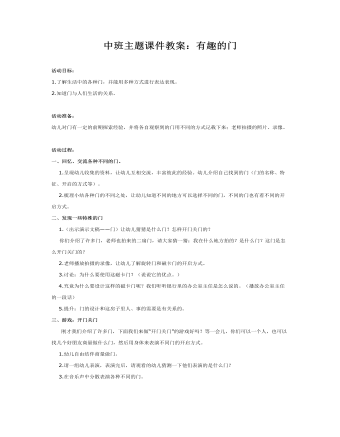
中班主题课件教案:有趣的门
活动准备:幼儿对门有一定的前期探索经验,并将各自观察到的门用不同的方式记载下来;老师拍摄的照片、录像。 活动过程:一、回忆、交流各种不同的门。 1.呈现幼儿收集的资料,让幼儿互相交流,丰富彼此的经验。幼儿介绍自己找到的门(门的名称、特征、开启的方式等)。 2.梳理小结各种门的不同之处,让幼儿知道不同的地方可以选择不同的门,不同的门也有着不同的开启方式。二、发现一些特殊的门 1.(出示演示文稿——门)让幼儿猜猜是什么门?怎样开门关门的? 你们介绍了许多门,老师也拍来的二扇门,请大家猜一猜:我在什么地方拍的?是什么门?这门是怎么开门关门的?
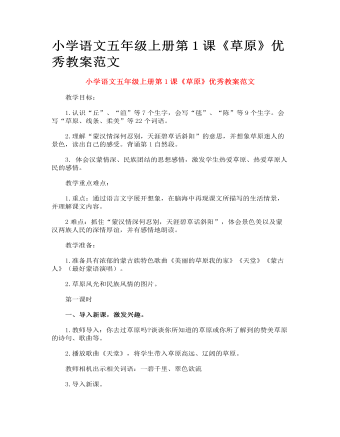
小学语文五年级上册第1课《草原》优秀教案范文
初读课文,学习字词。 1.提出读书要求:默读课文,一边读一边画出不认识的字和不理解的词,并借助词典等学习工具书理解。 2.教师检查学生学习情况。 (1)检查生字读音。 小丘( qiū)渲染(xuàn )迂回( yū)蒙古包( měng ) 襟飘带舞( jīn )鄂温克(è) (2)指导易混淆的字。 “襟”是左右结构,左边是“衤”,与衣服有关,表示衣服胸前的部分。 “涩”是左右结构,右边下面是“止”,不能写成“上”。 “裳”下面是“衣”,与衣服有关。 “微”:中间部分不能少一横。 (3)理解较难的词语。 ①联系上下文理解词语。 草原上行车十分洒脱,只要方向不错,怎么走都可以。 “洒脱”的意思是:潇洒自然,不拘束。这个词语反映了草原的广阔无边。 ②理解“襟飘带舞”一词的意思,可以出示蒙古族鲜艳的服装来分析,意思是:衣襟和裙带随风舞动。 ③“翠色欲流”一词可以从难字入手理解,比如“欲”在这里表示“将要”的意思,“翠色欲流”就是绿得太浓了,将要流下来,写出了草原的绿,是充满生命力的。 ④鄂温克:我国少数民族之一,聚居在内蒙古自治区的东北部。
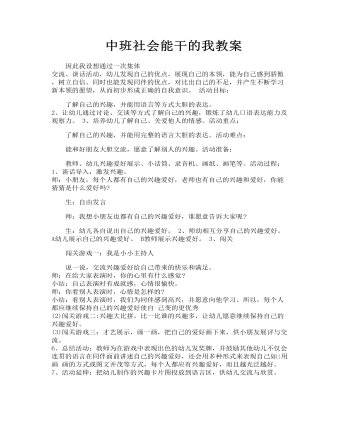
能干的小手中班教案中班社会能干的我教案
1、谈话导入,激发兴趣。 师:小朋友,每个人都有自己的兴趣爱好,老师也有自己的兴趣和爱好,你能猜猜是什么爱好吗? 生:自由发言 师:我想小朋友也都有自己的兴趣爱好,谁愿意告诉大家呢? 生:幼儿各自说出自己的兴趣爱好。 2、师幼相互分享自己的兴趣爱好。A幼儿展示自己的兴趣爱好。 B教师展示兴趣爱好。 3、闯关 闯关游戏一:我是小小主持人
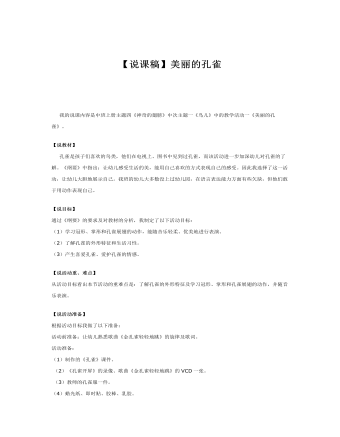
中班主题课件教案:美丽的孔雀(说课和教案)
【说教材】 孔雀是孩子们喜欢的鸟类,他们在电视上、图书中见到过孔雀,而该活动进一步加深幼儿对孔雀的了解。《纲要》中指出:让幼儿感受生活的美,能用自己喜欢的方式表现自己的感受。因此我选择了这一活动,让幼儿大胆地展示自己。我班的幼儿大多数没上过幼儿园,在语言表达能力方面有些欠缺,但他们敢于用动作表现自己。【说目标】通过《纲要》的要求及对教材的分析,我制定了以下活动目标:(1)学习冠形、掌形和孔雀展翅的动作,能随音乐轻柔、优美地进行表演。(2)了解孔雀的外形特征和生活习性。(3)产生喜爱孔雀、爱护孔雀的情感。【说活动重、难点】从活动目标看出本节活动的重难点是:了解孔雀的外形特征及学习冠形、掌形和孔雀展翅的动作,并随音乐表演。
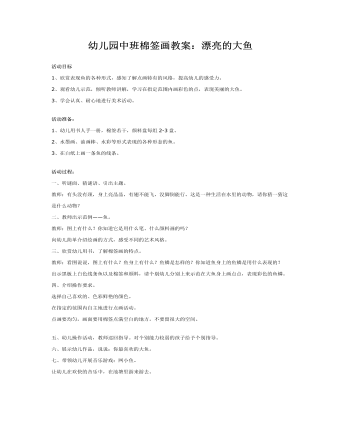
中班棉签画教案:漂亮的大鱼课件教案
2、观看幼儿示范,倾听教师讲解,学习在指定范围内画彩色的点,表现美丽的大鱼。 3、学会认真、耐心地进行美术活动。 活动准备: 1、幼儿用书人手一册,棉签若干,颜料盘每组2-3盘。 2、水墨画、油画棒、水彩等形式表现的各种形态的鱼。 3、在白纸上画一条鱼的线条。 活动过程:一、听谜面、猜谜语、引出主题。 教师:有头没有颈,身上亮晶晶,有翅不能飞,没脚倒能行。这是一种生活在水里的动物,请你猜一猜这是什么动物?
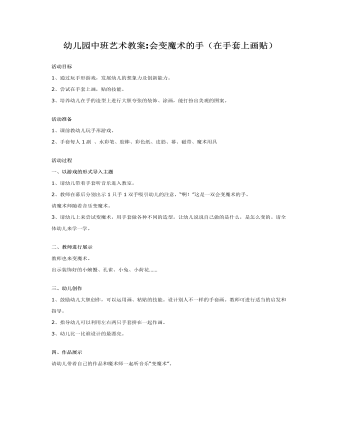
中班艺术教案:会变魔术的手课件教案
2、尝试在手套上画,贴的技能。 3、培养幼儿在手的造型上进行大胆夸张的装饰、涂画,能打扮出美观的图案。 活动准备 1、课前教幼儿玩手形游戏。 2、手套每人1副、水彩笔、胶棒、彩色纸、皮筋、幕、磁带、魔术用具活动过程一、以游戏的形式导入主题 1、请幼儿带着手套听音乐进入教室。 2、教师在幕后分别出示1只手1双手吸引幼儿的注意,“啊!”这是一双会变魔术的手。 请魔术师随着音乐变魔术。 3、请幼儿上来尝试变魔术,用手套做各种不同的造型。让幼儿说说自己做的是什么,是怎么变的。请全体幼儿来学一学。

小学语文修辞手法教案专题课件
1、明喻: 明喻就是本体、喻体和比喻词都出现的比喻。例句:例如:长城像一条长龙。这个句子中,“长城”是本体,“像”是比喻词,“一条长龙”是喻体。2、暗喻: 暗喻又叫隐喻,只出现本体和喻体,不用比喻词语或用“是、变成、成为、等于”等喻词。例句:例如:山间的云雾构成了一幅精妙的山水画。这个句子中“山间的云雾”是本体,“构成”是比喻词,“一幅精妙的山水画”是喻体。3、借喻: 借喻是只出现用来代替本体的喻体,而本体和喻词都不出现。例句:落光了叶子的柳树上挂满了毛茸茸、亮晶晶的银条儿。这个句子中,本体、比喻词均没有出现,喻体是“银条儿”。
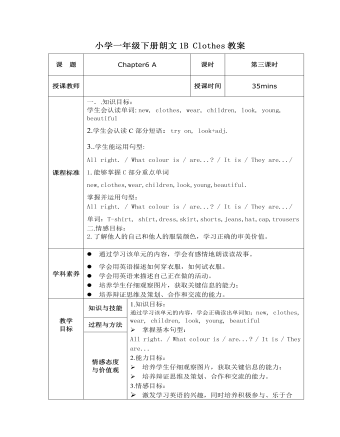
小学一年级下册朗文1B Clothes教案
一..知识目标:学生会认读单词: new, clothes, wear, children, look, young, beautiful2.学生会认读C部分短语:try on, look+adj. 3..学生能运用句型:All right. / What colour is /are...? / It is / They are.../1.能够掌握C部分重点单词new,clothes,wear,children,look,young,beautiful.掌握并运用句型:All right. / What colour is /are...? / It is / They are.../单词:T-shirt, shirt,dress,skirt,shorts,jeans,hat,cap,trousers二.情感目标:2.了解他人的自己和他人的服装颜色,学习正确的审美价值。
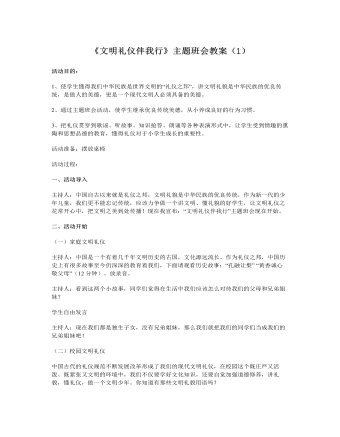
《文明礼仪伴我行》主题班会教案(1)
(一)家庭文明礼仪主持人:中国是一个有着几千年文明历史的古国,文化源远流长。作为礼仪之邦,中国历史上有很多故事至今仍深深的教育着我们,下面请观看历史故事:“孔融让梨” “黄香诚心敬父母”(12分钟)。放录音。主持人:看到这两个小故事,同学们觉得在生活中我们应该怎么对待我们的父母和兄弟姐妹?学生自由发言主持人:现在我们都是独生子女,没有兄弟姐妹,那么我们就把我们的同学们当成我们的兄弟姐妹吧!(二)校园文明礼仪中国古代的礼仪规范不断发展改革形成了我们的现代文明礼仪,在校园这个既庄严又活泼、既紧张又文明的环境中,我们不仅要学好文化知识,还要自觉加强道德修养,讲礼貌,懂礼仪,做一个文明少年。你知道有那些文明礼貌用语吗?
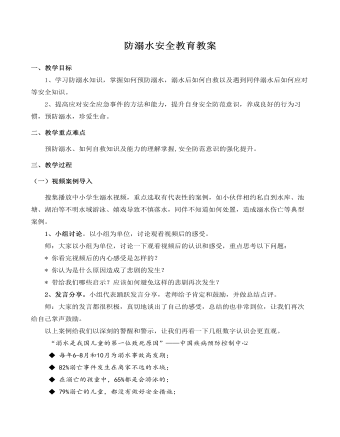
中小学生防溺水安全教育教案 (1)
(一)视频案例导入搜集播放中小学生溺水视频,重点选取有代表性的案例,如小伙伴相约私自到水库、池塘、湖泊等不明水域游泳、嬉戏导致不慎落水,同伴不知道如何处置,造成溺水伤亡等典型案例。1、小组讨论。以小组为单位,讨论观看视频后的感受。师:大家以小组为单位,讨论一下观看视频后的认识和感受,重点思考以下问题:* 你看完视频后的内心感受是怎样的?* 你认为是什么原因造成了悲剧的发生? * 带给我们哪些启示?应该如何避免这样的悲剧再次发生?2、发言分享。小组代表踊跃发言分享,老师给予肯定和鼓励,并做总结点评。师:大家的发言都很积极,真切地谈出了自己的感受,总结的也非常到位,让我们再次给自己掌声鼓励。
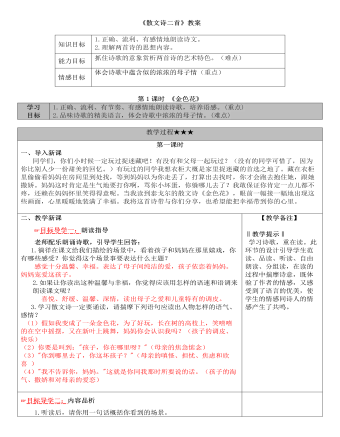
部编版语文七年级上册《散文诗二首》教案
?目标导学三:拓展延伸 1.请你模仿例句仿写。例句:母亲啊!你是荷叶,我是红莲,心中的雨点来了,除了你,谁是我在无遮拦天空下的荫蔽? 仿写: 示例一 :母亲啊,你是流水,我是鱼儿,当干旱来临时,除了你,谁还能为我提供一个安定的家?示例二:母亲啊,你是避风港,我是小船,狂风暴雨来临时,除了你,谁是我在无遮拦大海中的依靠? 示例三:母亲啊,你是鸟巢,我是小鸟,心中的寒冷来了,除了你,谁是我在冷风中的温暖? 2. 人说:天下的母亲有着不一样的面容,但唯有一样——母爱,是完全一样的。同学们,我们享受母爱十余载,那么你们的母亲是如何保护、关爱你们的呢?
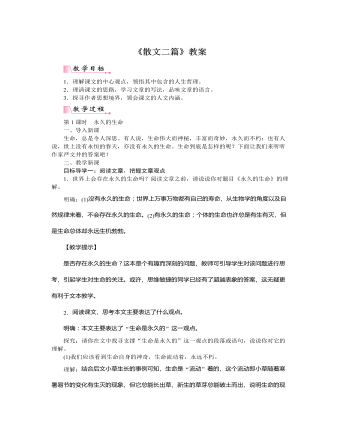
部编版语文八年级上册《散文两篇》教案
目标导学三:理解课文,把握内涵1.作者为什么把追求爱情作为活着的第一条理由?明确:作者说,追求爱情,有三方面的原因:第一,爱情可以带来狂喜;第二,爱情可以解除孤寂;第三,爱情的结合可以使人看到想象的仙境的神秘缩影。总之,爱情使人生活得更加美好;追求爱情,则是追求人生的境界。在这里,作者把爱情描写得极其美好,闪耀着人性的光辉。2.作者为什么追求知识?你能说说知识给你带来了什么吗?明确:一是可以了解人的心灵;二是可以了解星辰为什么发光;三是能够理解毕达哥拉斯的思想威力。这三方面实际上包含了人类知识的几个重要方面:人类、自然和社会。事实上,我们学习的知识,是人类在对世界的好奇心驱使下的创造,它给我们带来的不仅有解开世界之谜的快乐,还有思考过程本身的快乐。


